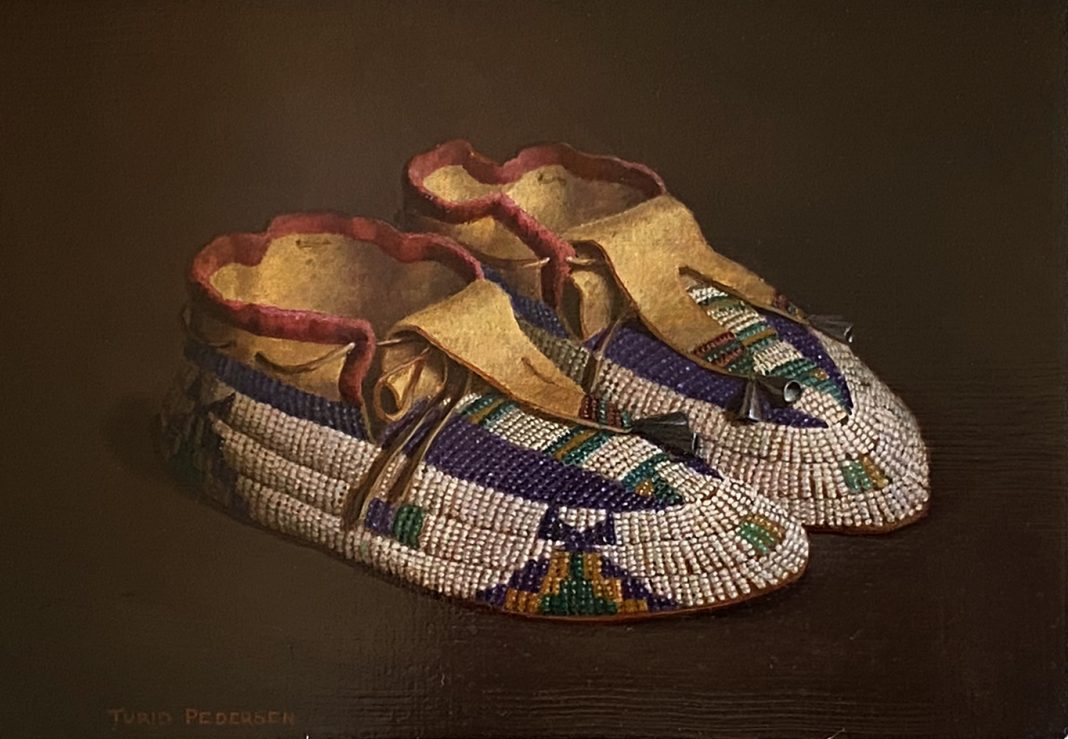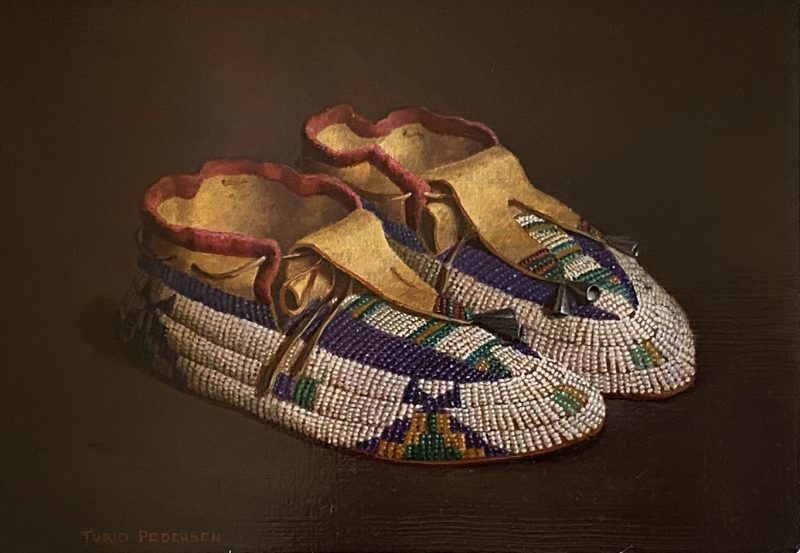Turid Pedersen Biography:
Turid Pedersen paints from life in a studio lit by northern light in her house in the historic district of Silver City, New Mexico. She loves “the cool, suffused light-what it does to modeling and shadows and the mood it creates.” While painting, “she looks for a quiet contemplative mood rather than for drama.”
Pedersen paints objects that are at hand, often Mimbres funerary bowls, a large collection of which are stored at Western New Mexico University in Silver City. These bowls are from the Mimbres Indian civilization that flourished in the mountains and river valleys surrounding Silver City from roughly 500 to 1200 A.D.
Pedersen’s affinity for Flemish masters and Spanish baroque painters is expressed through the extraordinary attention she lavishes on light and texture. “It’s a pleasure to be able to make something look real,” she says. “I love working with values and modeling to create the illusion of three-dimensional volumes on two-dimensional surfaces.” Yet Pedersen is not solely concerned with painterly effects.
“These paintings are meant to invoke a sense of stillness and contemplation, to make people think. Prehistoric artifacts are very rich in symbolism and associations. Storage containers and seed jars, for instance, speak volumes about survival in a land of little rain. It’s important for me to create a mood in my paintings that evokes the Mimbres world, their mysticism, the link between their daily lives rooted in Nature and the spirit world.”
FIRST ARTISTIC INSPIRATION
“Reidar Fritzwold was an artist and teacher who influenced me greatly,” Pedersen says. “I went to an arts high school where Fritzwold taught. He was a well-known Norwegian Painter in the late 1950’s and 1960’s whose own style tended toward the abstract. However, he was steeped in classical tradition and training, and he imparted this to me when I was his student in high school. He taught me the basics: drawing, perspective, shading, volumes, value scale, color theory, as well as teaching me how to imagine placing the image within the rectangle. Through him, I was introduced to the great fifteenth-century Flemish masters. Later, as an art history student living in Spain, I came across baroque painters such as Sanchez-Cotan, Felipe Ramirex and Zirbaran whose sense of heightened realism; use of light and shadow, and finished brush technique affected my work.”
“I don’t see my career in terms of having big breaks,” Pedersen says. “However, there have been a few things that have probably helped me. In 1997, I was invited to be a ‘demonstration artist’ at the Gilcrease Museum’s annual gala in Tulsa, Oklahoma. My work was featured and I gave a two-day demonstration on my painting technique. But, generally, rather than focusing on ‘breaks,’ I paint every day. I’m a working artist.”
When she was living in Houston in the early and mid seventies, Pedersen met Tamara de Lempicka, the notorious Parisian art deco painter from the twenties and thirties. “Madame Lempicka had moved to Houston to be near her daughter Kizette,” Pedersen recalls. “I met her through her granddaughter Cha-Cha. De Lempicka had been very successful as a portraiture painter in Europe between the World Wars. Her milieu had been the high society of France and Italy. She counted among her friends Jean Cocteau, Andre Gide, Coco Chanel, and Gabriele D’Annunzio.”
By the time Pedersen met her in the early seventies, De Lempicka’s reputation had almost vanished. “Although I didn’t study formally with her, De Lempicka took a liking to me. She would invite me over to her daughter’s house where she was staying and pull out canvases for me to look at. These were paintings from the twenties and thirties that she had saved. I was knocked out by them. Whole lost worlds leap out at me: the decadence and studied arrogance of her subjects as well as how she positioned them and her smooth, seamless, highly finished brushwork. Although my subject matter is much different than hers, her technique and chutzpah inspired me. At a crucial time, she gave me the courage to become a painter.”
FAVORITE SUBJECT
Still-life using historic and ancient Native American artifacts are her favorite subject to paint. Pedersen is meticulous in researching her subject matter. All the objects she paints come from museums or private collections. She sketches these works on the premises. Her favorite artifacts have often been Classic Era Mimbres funerary bowls. These delicately crafted bowls, created by Mimbers Indian artisans from about 1000 to 1250 A.D., served as symbolic vessels to help a deceased relative make the journey from the earth realm to the underworld of the ancestors.
The hole that is always punched into the center of the pot mimics what the Zuni call the sipa’pu, the hole in the underworld sky that enabled the ancestors to enter and create the earthly world. Classic Era Mimbres pottery painting is almost always black on white. These colors in combination are deeply symbolic: white represents the nadir, the direction underneath a person’s feet, while black represents the zenith, the point highest above one’s head. On their bowls, the Mimbres developed an utterly individual style of iconographic painting, often combining human and animal elements to make anthropomorphic figures or mythical creatures.
AWARDS AND ACCOLADES
First Prize and Gold Medal, 1992 Prairie Fire Invitational Show, Wichita, Kansas.
Featured Artist, Gilcrease Museum Rendezvous 1997, Tulsa, Oklahoma.
Faculty, 1996-2000, Scottsdale Artist’s School, Scottsdale, Arizona.
Invited participant in the National Cowgirl Museum Show, November 2004.
Available painting:
Click on images to enlarge.
“Beaded Plains Indian Moccasins”
Turid Pedersen
oil 5″ x 7″
Was: $1,200
NOW: $1,000
See additional information about “Beaded Plains Indian Moccasins”.
See it First!
Receive notifications from America's online art gallery when the latest works from top artists are available.




